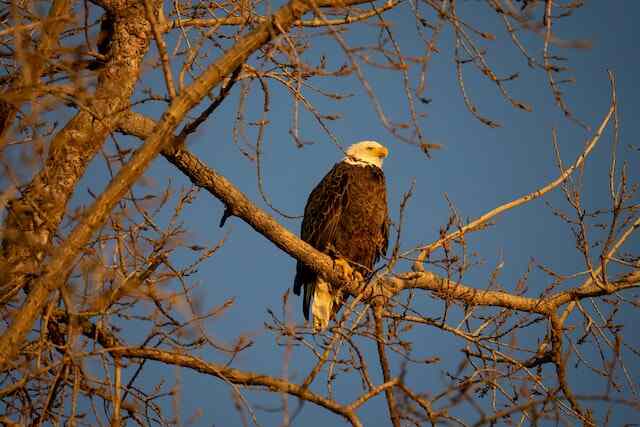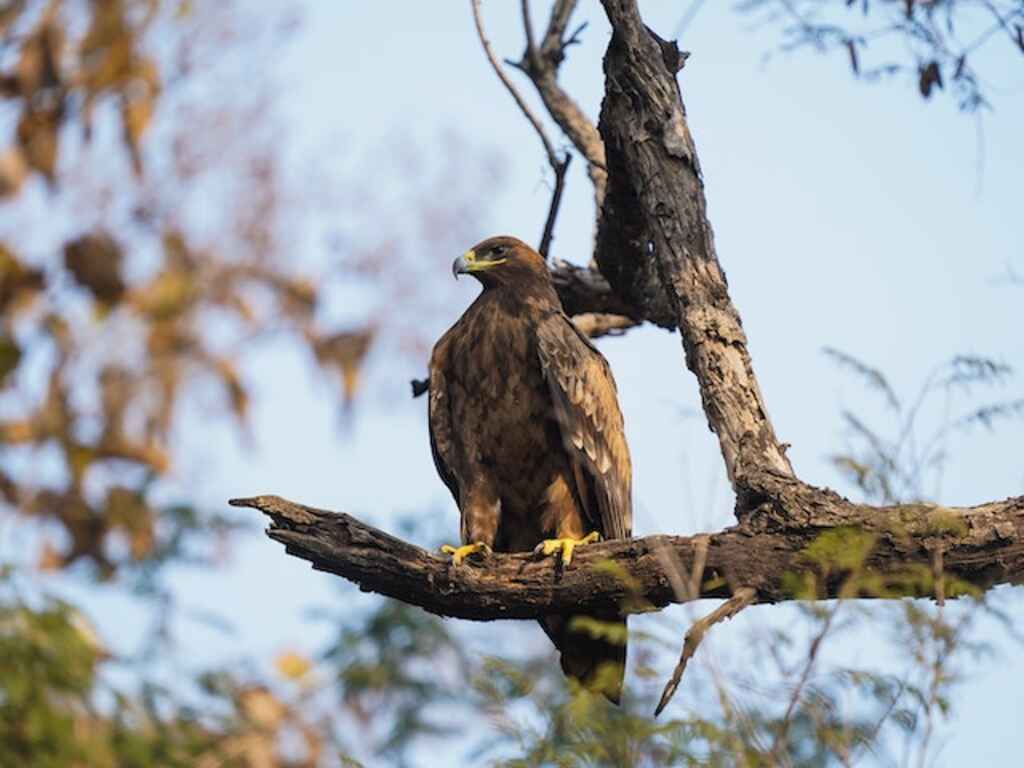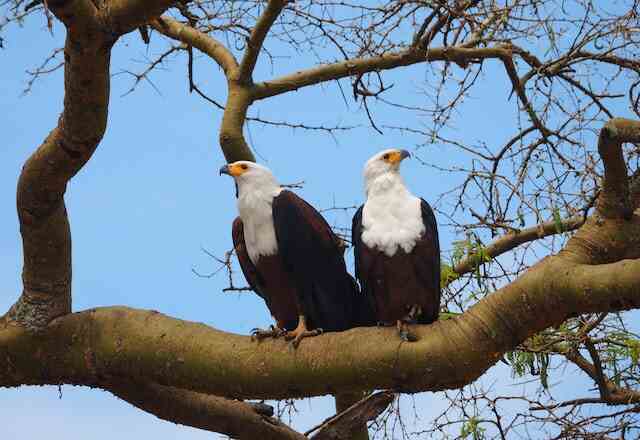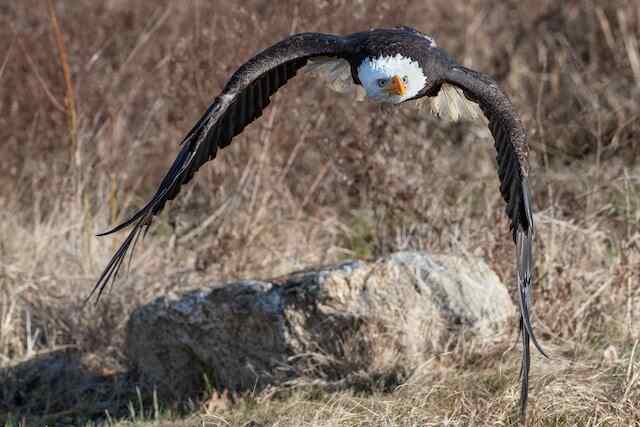Do Eagles Eat Bugs? Unveil the fascinating dietary habits of eagles as we explore their menu beyond small mammals and fish.
Discover the rare instances when these majestic birds indulge in grasshoppers, beetles, and dragonflies. Uncover their adaptability, survival strategies, and ecological prowess.
Prepare to be astounded by the hidden world of eagle dining. Stay tuned for captivating insights and surprising facts about these magnificent creatures.
Table of Contents
- 1 Key Takeaways
- 2 Types of Prey Eagles Typically Consume
- 3 Factors Affecting Eagle Diet
- 4 Availability of Prey
- 5 Geographic Location
- 6 Seasonal Variations
- 7 The Role of Bugs in Eagle Diet
- 8 Do Eagles Eat Bugs?
- 9 How Bugs Fit into the Food Chain
- 10 Importance of Insects for Eagle Survival
- 11 Eagle Feeding Behaviors
- 12 Hunting Techniques
- 13 Feeding Habits and Frequency
- 14 Food Storage and Consumption Patterns
- 15 Scientific Studies on Eagle Diets
- 16 Research Findings and Observations
- 17 Studies on Eagle Digestion and Nutritional Needs
- 18 Environmental Impact and Conservation
- 19 Interactions Between Eagles and Bug Populations
- 20 Effects of Environmental Changes on Eagle Diet
- 21 Conservation Efforts to Protect Eagle Habitats
- 22 Misconceptions About Eagle Diets
- 23 Common Myths and Misunderstandings
- 24 Clarifying the Facts About Eagle Feeding Habits
- 25 Observing Eagles in the Wild
- 26 Recommended Locations for Eagle Watching
- 27 Tips for Spotting Eagles in their Natural Habitat
- 28 Other Interesting Facts About Eagles
- 29 Unique Adaptations for Hunting and Survival
- 30 Comparisons with Other Bird Species
- 31 Frequently Asked Questions
- 31.1 Do eagles have a specific preference for certain types of bugs?
- 31.2 How do bugs contribute to the overall nutritional requirements of eagles?
- 31.3 Are there any negative effects on eagle populations if bug populations decline?
- 31.4 Do eagles rely on bugs as a primary food source or are they just a supplement to their diet?
- 31.5 Are there any specific hunting techniques that eagles use when targeting bugs as prey?
- 32 Conclusion
- 33 Author
Key Takeaways
- Insects are an important source of nutrition for eagles, providing essential nutrients like protein, vitamins, and minerals.
- Understanding the role of bugs in the food chain is crucial for understanding eagle’s dietary needs.
- Conservation of insect populations is important for the long-term survival of eagles.
- Eagles occasionally incorporate insects into their diet, indirectly contributing to regulating insect populations and maintaining ecosystem balance.

Types of Prey Eagles Typically Consume
Eagles primarily consume a diverse range of prey, including small mammals, fish, reptiles, and birds of various sizes. These majestic birds employ a variety of hunting techniques to capture their prey.
For instance, eagles often soar high above their hunting grounds, scanning the landscape with their keen eyesight to spot potential targets.
Once a suitable prey is detected, the eagle will descend rapidly, using its powerful talons to snatch the unsuspecting victim.
Some larger species of eagles are even capable of taking down larger animals, such as deer or monkeys.
Additionally, eagles are known to exhibit different feeding behaviors depending on the availability of prey.
When food is abundant, they may consume large quantities in one sitting and store excess food in their nests for later consumption.
On the other hand, during periods of scarcity, eagles have been observed to exhibit more opportunistic feeding behaviors, scavenging on carrion or stealing food from other predators.
These eagle hunting techniques and feeding behaviors contribute to their ability to adapt to different environmental conditions.
Factors affecting eagle diet include the availability of prey species, competition with other predators, and habitat changes.
Consequently, eagles exhibit a remarkable ability to adjust their diet based on these factors, ensuring their survival in a constantly changing ecosystem.
Factors Affecting Eagle Diet
Factors such as habitat, prey availability, and competition influence the dietary choices of these majestic birds.
Eagles have a range of foraging techniques that they employ to catch their prey, including soaring and scanning the ground for food, hunting from perches or trees, and even stealing food from other birds.
However, their ability to find and catch prey is heavily influenced by their habitat. Habitat loss, caused by factors such as deforestation and urbanization, can have a significant impact on eagle diet.
When their natural habitats are destroyed or fragmented, eagles may struggle to find suitable prey, leading to a shift in their diet or even a decline in their population.
This highlights the importance of preserving and protecting the habitats of these magnificent birds.
Transitioning into the subsequent section about the availability of prey, it is crucial to understand how changes in habitat can affect the overall food sources for eagles.
Availability of Prey
Prey availability significantly impacts the dietary options of eagles, as it determines the range of food sources they have access to.
The bug population dynamics play a crucial role in the availability of prey for eagles. With their incredible eyesight, eagles are adept at spotting and capturing insects, which form an essential part of their diet.
However, the availability of bugs can be influenced by various factors, including climate change.
Changes in temperature and precipitation patterns can directly impact insect populations, leading to fluctuations in their abundance and distribution.
Climate change can also affect the timing of insect emergence and their life cycle, which in turn affects the availability of prey for eagles.
As insect populations decline or become irregular due to climate change, eagles may face challenges in finding an adequate food supply.
Understanding the impact of climate change on insect availability is crucial for conservation efforts aimed at protecting eagle populations.
This knowledge can help inform strategies to mitigate the effects of climate change on prey availability and ensure the long-term survival of these magnificent birds.
Transitioning into the subsequent section about ‘geographic location’, it is important to consider how the availability of prey can vary depending on the specific habitat and location of eagle populations.
Geographic Location
Situated across diverse landscapes, eagle populations are scattered like stars in the night sky, each one adapting to the unique challenges and opportunities presented by their geographic location.
The effects of climate change have had a significant impact on insect populations, which in turn affects the diet of eagles.
As temperatures rise and weather patterns shift, certain insect species may decline or become less abundant in specific regions.
This can pose a challenge for eagles that rely on insects as a food source, as it may require them to adjust their foraging behavior or seek alternative prey.
Additionally, changes in insect populations can have cascading effects throughout the ecosystem, potentially disrupting the delicate balance of predator-prey relationships.
Understanding how eagles respond to these changes in their environment is crucial for conservation efforts and ensuring their survival.
Transitioning into the subsequent section about ‘seasonal variations,’ it is important to examine how eagles navigate through the shifting availability of insects during different times of the year.

Seasonal Variations
Throughout the year, the ever-changing availability of insects poses a constant challenge for eagles, forcing them to adapt their foraging strategies in order to secure a stable food source.
Insect migration plays a significant role in this seasonal variation, as certain insect species migrate to different regions in response to changing temperatures and resources.
For eagles, this means that they must track and follow these insect migrations in order to find their prey.
Furthermore, climate change has started to impact insect populations, with some species experiencing shifts in their geographical distribution and abundance.
This means that eagles may need to adjust their foraging behaviors even more, as they navigate the changing landscape of insect availability.
Despite these challenges, eagles are highly adaptable and have developed remarkable hunting skills to capture insects on the wing.
They use their sharp talons to snatch insects out of the air, relying on their keen eyesight and precise aerial maneuvers to successfully catch their prey.
This constant interaction with insects not only ensures a stable food source for eagles but also plays a crucial role in the ecosystem as eagles help control insect populations.
Transitioning to the subsequent section about the role of bugs in the eagle diet, the availability and variety of insects are vital for sustaining the health and survival of eagles.
The Role of Bugs in Eagle Diet
In the previous subtopic, we discussed the seasonal variations in the diet of eagles. Now, let us delve into the current subtopic, which focuses on the role of bugs in the eagle diet.
Bugs, particularly insects, play a crucial role in the ecosystem as they serve as a vital food source for various organisms.
Eagles, being opportunistic predators, are known to incorporate insects into their diet, especially during certain times of the year when insects are more abundant.
However, it is important to note that the impact of insect decline on the eagle diet cannot be overlooked.
With the alarming decline in insect populations worldwide, eagles may face challenges in finding an adequate supply of insects to sustain their diet.
This decline in insect populations could potentially have adverse effects on eagle populations as well.
Now, let us explore the question: do eagles actually eat bugs?
Do Eagles Eat Bugs?
Found within the eagle’s diet are a variety of small invertebrates, including insects, which serve as an important source of nutrition.
Insects play a crucial role in the eagle’s diet by providing essential nutrients such as protein, vitamins, and minerals.
They are a readily available food source that eagles can easily catch and consume.
The impact of bugs on eagle survival is significant, as they contribute to the overall health and well-being of these majestic birds.
By consuming insects, eagles are able to maintain their energy levels and sustain their physical activities, such as flying and hunting.
The role of insects in the eagle’s diet is not to be underestimated, as it directly affects their survival and ability to thrive in their natural habitats.
Understanding how bugs fit into the food chain is essential to gaining a comprehensive understanding of the eagle’s dietary needs and their place within the ecosystem.
How Bugs Fit into the Food Chain
Bugs play a crucial role in the food chain and ecosystem, as they serve as a vital food source for many organisms, including birds like eagles.
Understanding the factors that affect bug populations is essential in comprehending their significance in the ecosystem.
Several factors influence the abundance and distribution of bugs, such as temperature, humidity, availability of food and shelter, and the presence of predators and diseases.
These factors can greatly impact bug populations, leading to fluctuations in their numbers and species composition.
The importance of bugs in the ecosystem extends beyond their role as a food source for eagles and other organisms.
Bugs also contribute to nutrient recycling, pollination, and decomposition processes, which are essential for the overall functioning and balance of ecosystems.
Therefore, recognizing the multifaceted roles bugs play in the ecosystem is crucial for understanding the intricate connections between organisms and their environments.
Transitioning into the subsequent section, the importance of insects for eagle survival goes beyond their role as a mere food source.
Importance of Insects for Eagle Survival
The intricate web of ecological relationships is exemplified by the reliance of eagles on the delicate balance of insect populations, which act as a linchpin in sustaining their survival.
Insects play a crucial role in the diet of eagles, providing them with essential nutrients and energy.
While eagles are primarily known for their ability to catch and consume larger prey like fish and small mammals, they also heavily rely on insects to meet their nutritional needs.
Insects are a rich source of protein, vitamins, and minerals, which are vital for the growth, development, and overall health of eagles.
Additionally, insects are often more readily available and accessible to eagles, especially during certain times of the year or in specific habitats.
Therefore, understanding and conserving insect populations is of utmost importance for the long-term survival of eagles.
By studying insect population dynamics and implementing effective insect conservation strategies, we can ensure that eagles have a sustainable food source and maintain a healthy population.
Transitioning to the subsequent section about ‘eagle feeding behaviors’, it is fascinating to explore how eagles utilize their hunting skills to catch both insects and larger prey.

Eagle Feeding Behaviors
The importance of insects for eagle survival is undeniable, as they serve as a crucial food source for these magnificent birds.
Understanding eagle feeding behaviors is essential in comprehending their ecological role and impact on the ecosystem.
Eagles exhibit distinct feeding patterns that vary depending on the species and the availability of prey.
They primarily feed on fish, small mammals, reptiles, and birds, but they also consume insects, including bugs.
Although eagles are not specialized insect-eaters, they occasionally incorporate insects into their diet, especially during certain seasons or when other prey sources are scarce.
While the consumption of bugs may not be a primary food source for eagles, it does play a role in their feeding habits and overall ecological contribution.
By consuming insects, eagles indirectly contribute to regulating insect populations and maintaining the balance within their respective ecosystems.
Their feeding behaviors have a ripple effect on the entire food web, as the reduction or increase in insect numbers can influence the abundance of other organisms.
As we delve further into the hunting techniques employed by eagles, we can gain a deeper understanding of their remarkable adaptability and prowess in capturing prey.
Hunting Techniques
Employing various hunting techniques, eagles demonstrate their adaptability and precision as they skillfully capture their prey.
These majestic birds possess remarkable hunting skills that allow them to thrive in diverse environments.
One technique commonly employed by eagles is called soaring and scanning. Eagles use their keen eyesight to scan the landscape below while soaring at great heights, searching for potential prey.
Once a target is spotted, eagles swiftly dive towards their prey, using their powerful wings to gain momentum.
Another technique is called perch hunting, where eagles perch on trees or high vantage points, patiently observing their surroundings.
When an opportunity arises, they swoop down with incredible speed and accuracy to snatch their prey.
Eagles also use a technique known as fishing, where they hover above bodies of water and then plunge into the water to catch fish with their sharp talons.
These hunting techniques highlight the adaptability and resourcefulness of eagles as they pursue their prey.
Transitioning into the subsequent section about feeding habits and frequency, it is important to explore how these hunting techniques impact the eagles’ overall feeding behaviors.
Feeding Habits and Frequency
Feeding on a variety of prey, eagles exhibit a voracious appetite, consuming their meals with precision and efficiency.
Eagles have a diverse diet, which includes fish, small mammals, reptiles, and birds.
This dietary diversity is essential for their survival, as it ensures that they are able to adapt to different environments and find food sources even when their preferred prey may be scarce.
However, the impact of pollution on eagle diets cannot be ignored.
Pollution, particularly the accumulation of toxins like pesticides and heavy metals in water bodies, can have detrimental effects on the health and availability of their prey.
This can lead to a decrease in the diversity of their diet and potentially affect their overall population.
Despite these challenges, eagles continue to demonstrate their resilience by adjusting their feeding habits and seeking out alternative food sources.
Therefore, understanding the impact of pollution on eagle diets is crucial for conservation efforts.
Now, let’s explore the next section on food storage and consumption patterns.
Food Storage and Consumption Patterns
Food storage and consumption patterns in eagles reveal their ability to adapt and optimize their foraging strategies based on the availability and accessibility of prey.
Eagles employ various food storage techniques to ensure a steady supply of nutrition.
Firstly, they may store excess prey in hidden locations, such as tree branches or rocky crevices, to consume at a later time when prey is scarce.
Secondly, eagles exhibit a behavior known as ‘caching,’where they bury prey items in the ground or cover them with vegetation for future consumption.
This technique helps them to preserve and protect their food from other scavengers.
Lastly, eagles may consume large quantities of prey at once, allowing them to sustain themselves for longer periods without the need to hunt frequently.
These food storage and consumption patterns allow eagles to meet their nutritional requirements and maximize their foraging efficiency.
Transitioning into the subsequent section about scientific studies on eagle diets, these intricate strategies highlight the importance of understanding the dietary preferences and behaviors of eagles through rigorous scientific investigations.

Scientific Studies on Eagle Diets
Conducting scientific studies to investigate the dietary preferences and foraging behaviors of eagles allows researchers to gain insight into their ecological roles and contribute to a broader understanding of predator-prey dynamics in ecosystems.
One key aspect of these studies is to examine eagle feeding preferences and how they are influenced by the availability of prey.
By analyzing the contents of eagle stomachs or regurgitated pellets, researchers can identify the types of prey consumed and determine the relative importance of different prey species in their diet.
Additionally, researchers can study the foraging behaviors of eagles, such as their hunting techniques and habitat selection, to understand how they locate and capture their prey.
These studies provide valuable information on the ecological niche of eagles and their impact on prey populations.
By understanding the feeding preferences of eagles and the factors that influence their prey selection, researchers can contribute to the management and conservation of ecosystems.
Transitioning to the subsequent section about research findings and observations, these scientific investigations have revealed fascinating insights into the dietary habits of eagles and their role as top predators in their respective ecosystems.
Research Findings and Observations
Research findings and observations have unveiled intriguing details about the dietary preferences and foraging behaviors of eagles, shedding light on their ecological roles and contribution to predator-prey dynamics in ecosystems.
Studies on eagle migration patterns have revealed that these majestic birds undertake long-distance journeys to find suitable habitats and food sources.
They have been observed to travel thousands of miles, utilizing thermals and wind patterns to aid their flight.
Additionally, research has shown that eagles are highly adaptable in their diet, consuming a variety of prey items including fish, small mammals, and birds.
However, the impact of pollution on eagle diet is a growing concern.
Studies have demonstrated that environmental contaminants, such as pesticides and heavy metals, can accumulate in eagle prey and subsequently affect their health and reproductive success.
This highlights the importance of understanding the interactions between eagles and their environment, as well as the need for conservation efforts to mitigate the effects of pollution on these magnificent creatures.
Transitioning into the subsequent section about studies on eagle digestion and nutritional needs, further investigation is needed to explore how eagles process and extract nutrients from their diverse diet to support their energy demands and maintain optimal health.
Studies on Eagle Digestion and Nutritional Needs
Studies on eagle digestion and nutritional needs have provided valuable insights into their feeding behavior and requirements.
Eagles are known to be opportunistic feeders, consuming a wide range of prey including fish, small mammals, reptiles, and birds.
However, their diet also includes a significant portion of insects and bugs.
Research has shown that insects provide essential nutrients such as proteins, vitamins, and minerals that are crucial for the growth and maintenance of eagle populations.
In fact, the consumption of bugs by eagles is not only a result of opportunistic feeding but also a strategic choice to meet their nutritional requirements.
This is further supported by studies that have found a positive correlation between insect consumption and reproductive success in eagles.
Additionally, the high energy content of insects makes them an important food source for eagles, especially during periods of increased energy demands such as breeding and migration.
Overall, understanding the role of bugs in eagle feeding behavior and their nutritional needs is vital for their conservation and management.
Moving forward, it is important to explore the environmental impact of eagle feeding habits and develop strategies for their conservation and sustainable management.
Environmental Impact and Conservation
The intricate web of interactions between eagles and their environment highlights the importance of understanding the environmental impact of their feeding habits and the need for effective conservation strategies.
One significant concern regarding eagle populations is their decline, which can be attributed to various factors, including the impact of pollution.
Pollution, particularly through the contamination of water bodies, can lead to a decrease in the availability of prey for eagles, such as fish and other aquatic organisms.
This scarcity of food sources can directly affect eagle populations, as it reduces their reproductive success and overall survival rates.
Furthermore, the accumulation of pollutants in the bodies of eagles can result in physiological and reproductive abnormalities, further exacerbating their population decline.
Therefore, effective conservation strategies must address the issue of pollution and its impact on eagle populations.
By mitigating pollution and promoting the conservation of their habitats, we can help safeguard the future of these majestic birds.
Understanding the interactions between eagles and bug populations is crucial in comprehending the broader ecological dynamics at play.

Interactions Between Eagles and Bug Populations
Interactions between eagles and bug populations contribute to the intricate ecological dynamics within their environment.
Bug population dynamics play a crucial role in shaping the overall health and stability of ecosystems.
Bugs, such as insects and arthropods, serve as a vital food source for eagles and other predatory birds.
The impact of bug populations on the ecosystem extends beyond simply providing sustenance for eagles.
Bugs play a significant role in pollination, decomposition, and nutrient cycling, thereby influencing the overall biodiversity and functioning of the ecosystem.
Moreover, the abundance or scarcity of bugs can have cascading effects on other organisms within the food web.
Understanding the dynamics between eagles and bug populations is essential for comprehending the broader ecological interactions that shape the environment.
Transitioning into the subsequent section about the effects of environmental changes on eagle diet, it is crucial to examine how alterations in bug populations due to environmental factors can impact the feeding habits and diet of eagles.
Effects of Environmental Changes on Eagle Diet
Under the influence of environmental changes, the dietary composition of eagles undergoes a fascinating transformation, revealing the intricate interplay between their feeding habits and the availability of prey.
Eagles, being highly adaptable and opportunistic predators, respond to changes in their environment by altering their diet to ensure their survival.
The effects of climate change, for example, can have a significant impact on prey availability for eagles.
As temperatures rise and habitats shift, the distribution and abundance of certain insect species may be affected. This, in turn, can influence the availability of bugs for eagles to feed on.
Additionally, changes in precipitation patterns can also impact insect populations, further altering the prey base for these majestic birds.
The ability of eagles to adapt their feeding habits in response to these environmental changes is a testament to their resilience and flexibility as top predators.
By understanding the effects of climate change on prey availability, researchers and conservationists can better inform conservation efforts to protect eagle habitats and ensure the long-term survival of these magnificent birds.
Conservation Efforts to Protect Eagle Habitats
The effects of environmental changes on eagle diet have highlighted the need for conservation efforts to protect their habitats.
As human activities continue to encroach upon eagle habitats, it becomes crucial to implement strategies that safeguard these majestic birds and restore their habitats.
Conservation efforts often involve habitat restoration projects, which aim to recreate or enhance the natural conditions necessary for eagles to thrive.
These projects may include reforestation, removal of invasive species, and the establishment of protected areas.
By focusing on the preservation and restoration of eagle habitats, conservation initiatives contribute to the overall health and well-being of these birds, ensuring their continued existence.
Transitioning into the subsequent section about misconceptions about eagle diets, it is important to address the common misconceptions that surround the feeding habits of these remarkable creatures.
Misconceptions About Eagle Diets
One common misconception prevailing about the feeding habits of eagles is the inaccurate belief that they primarily consume small mammals and fish as their main sources of sustenance.
However, this misconception fails to acknowledge the misunderstood feeding habits of eagles and the crucial ecological role that insects play in their diet.
While it is true that eagles do consume small mammals and fish, their diet is more diverse than commonly believed.
Insects, such as beetles, grasshoppers, and even spiders, are an essential part of their diet.
These insects provide a vital source of nutrition for eagles, offering high protein content and essential nutrients.
Moreover, by consuming insects, eagles contribute to the regulation of insect populations, thus playing a significant ecological role.
Understanding the importance of insects in the diet of eagles helps dispel the myth that they solely rely on small mammals and fish for sustenance.
This highlights the need to recognize the true dietary habits of eagles and the broader ecological implications of their feeding behaviors.
Moving forward, it is important to address common myths and misunderstandings surrounding eagle diets in order to promote a more accurate understanding of these majestic birds.

Common Myths and Misunderstandings
Contrary to popular belief, the feeding habits of eagles encompass a wider range than commonly assumed, challenging the notion that eagles solely rely on small mammals and fish for sustenance.
While eagles are widely known for their hunting prowess and ability to catch fish, they also play a significant role in insect control within their ecosystems.
In fact, insects form an important part of the eagle diet, especially during certain times of the year.
Eagles are opportunistic feeders and will consume a variety of insects, including beetles, grasshoppers, and dragonflies.
These insects provide a valuable source of nutrition, containing essential vitamins, minerals, and proteins.
Additionally, insects are abundant and relatively easy for eagles to catch, making them an attractive food source.
Moreover, the consumption of insects by eagles helps regulate insect populations, contributing to the balance of ecosystems.
Understanding the bug eating habits of eagles is crucial for comprehending their ecological role and overall impact on the environment.
By clarifying the facts about eagle feeding habits, we can gain a better understanding of their complex dietary preferences and the intricate balance of nature.
Clarifying the Facts About Eagle Feeding Habits
In order to gain a comprehensive understanding of the intricacies of eagle feeding habits, it is essential to delve into the ecological role they play and the impact they have on the environment.
Eagles, as apex predators, have a significant influence on the ecosystem they inhabit.
While they are known for their ability to hunt and consume larger prey such as fish and small mammals, they also play a crucial role in controlling insect populations.
Bugs, particularly aquatic insects, serve as indicators of the overall health of an ecosystem.
By preying on these insects, eagles help maintain a balance in the ecosystem and prevent outbreaks of certain insect species. Their feeding habits contribute to the overall stability and biodiversity of their habitat.
Observing eagles in the wild allows us to witness firsthand the impact they have on the environment and appreciate the intricate web of interactions that exist within ecosystems.
Transitioning into the subsequent section about observing eagles in the wild, it becomes evident that studying their feeding habits is just one aspect of understanding these majestic creatures.
Observing Eagles in the Wild
A study conducted in 2019 found that eagles spend an average of 6 hours per day engaged in hunting and foraging activities.
This suggests that observing eagles in the wild can provide valuable insights into their feeding habits.
Eagles play a crucial role in maintaining the balance of ecosystems, as they primarily feed on a variety of prey, including bugs.
Bugs, such as insects and arachnids, are an essential part of the ecosystem as they contribute to pollination, decomposition, and the control of pest populations.
Therefore, the importance of bug populations cannot be underestimated.
However, the decline in bug populations due to various factors, such as habitat loss and pesticide use, has had a significant impact on eagle diets.
With the decrease in bug availability, eagles have had to adapt their foraging strategies and diversify their diet.
This adaptation is crucial for their survival and the overall health of the ecosystem.
Understanding the impact of bug decline on eagle diets can help researchers and conservationists develop strategies to protect bug populations and ensure the long-term survival of eagles.
Transitioning into the subsequent section about recommended locations for eagle watching, it is important to note that observing eagles in their natural habitats can provide a deeper appreciation for their feeding habits and the challenges they face in finding prey.
Recommended Locations for Eagle Watching
One can discover breathtaking opportunities for eagle watching by visiting recommended locations known for their abundant eagle populations.
These locations offer a chance to observe the majestic birds in their natural habitat, providing valuable insights into their nesting habits and migration patterns.
Eagles are known to build their nests in tall trees near bodies of water, such as rivers, lakes, or coastal areas.
These locations provide ample food sources for the eagles, as they primarily feed on fish and small mammals.
During migration, eagles can be found in various regions, depending on the time of year.
For example, in North America, they can be spotted along the Pacific Northwest coast during the winter months, as they follow the migration patterns of their prey.
By understanding these patterns, eagle enthusiasts can plan their visits to coincide with the best times for spotting these magnificent creatures.
With this knowledge, one can transition into the subsequent section about tips for spotting eagles in their natural habitat, allowing for a seamless continuation of the discussion about eagle watching.
Tips for Spotting Eagles in their Natural Habitat
When it comes to spotting eagles in their natural habitat, understanding their migration patterns and nesting behaviors can greatly increase your chances of success.
Eagles are known to migrate between different regions, following predictable routes that are influenced by factors such as weather conditions and food availability.
By studying these migration patterns, you can identify the best times and locations to observe eagles in flight.
Additionally, eagles are highly territorial creatures and tend to return to the same nesting sites year after year.
By familiarizing yourself with their nesting behaviors, such as their preference for tall trees near bodies of water, you can narrow down the areas where you are most likely to find them.
To enhance your eagle spotting experience, here are four tips to keep in mind:
1) Research the migration patterns of eagles in your region to determine the optimal time to observe them.
2) Look for areas with suitable nesting habitats, such as tall trees near water bodies.
3) Use binoculars or a spotting scope to help you spot eagles from a distance.
4) Be patient and observe quietly, as any sudden movements or loud noises may startle the eagles and cause them to fly away.
By following these tips, you can increase your chances of spotting these majestic birds in their natural habitat. Now, let’s delve into other interesting facts about eagles.
Other Interesting Facts About Eagles
Eagles, with their remarkable vision, have been likened to nature’s telescopes, enabling them to spot their prey from great distances.
These majestic birds are known for their impressive migration patterns, with some species traveling thousands of miles each year to find suitable breeding grounds and food sources.
During their migrations, eagles rely on their keen sense of direction and navigation skills to find their way, often using landmarks and celestial cues.
When it comes to mating rituals and courtship behaviors, eagles engage in elaborate displays to attract a mate.
These displays can include aerial acrobatics, vocalizations, and even gift-giving. Once a pair has formed, they build a large nest together, often in tall trees or on cliffs, where they raise their young.
This process involves intricate bonding behaviors and shared responsibilities between the male and female.
As the young eaglets grow, they learn essential survival skills from their parents, including hunting techniques and territorial defense.
These fascinating behaviors and adaptations for mating and survival highlight the incredible complexity of eagle behavior.
Moving forward to the next section on ‘unique adaptations for hunting and survival,’ eagles demonstrate remarkable physical and behavioral adaptations that allow them to thrive in their natural habitats.
Unique Adaptations for Hunting and Survival
To optimize their hunting success and survival, eagles possess a multitude of unique adaptations that enable them to navigate their environment and secure prey efficiently.
One of the key hunting strategies employed by eagles is their exceptional eyesight.
With eyes that are up to eight times more powerful than that of humans, eagles can spot their prey from great distances, even while soaring at high altitudes.
This keen eyesight, combined with their ability to rotate their heads almost 180 degrees, allows them to scan their surroundings for potential prey with remarkable precision.
Another unique adaptation is their sharp, curved beak, which is specifically designed for tearing and gripping prey. The beak is also equipped with sharp, pointed edges that aid in killing and dismembering their catch.
Additionally, eagles possess strong, muscular legs and talons that enable them to capture and carry prey that may be larger than their own body weight.
These powerful talons lock into place, providing a secure grip on the prey as the eagle carries it to a safe location for consumption.
With such unique hunting adaptations, eagles are able to thrive in their environment and secure their next meal.
Transitioning into the subsequent section about comparisons with other bird species, it is interesting to note how these adaptations differ from those found in other avian predators.

Comparisons with Other Bird Species
In comparison to other bird species, the unique adaptations of eagles, such as their powerful eyesight, sharp beak, and strong talons, set them apart as highly efficient predators.
Eagles possess exceptional eyesight, enabling them to spot prey from great distances and accurately assess their surroundings.
This ability allows them to target specific prey and successfully hunt in various environments.
Additionally, their sharp beak is a versatile tool that allows them to tear through the flesh of their prey with ease. This adaptation is especially beneficial when hunting small mammals, fish, or reptiles.
Furthermore, their strong talons provide them with a firm grip on their prey, ensuring that it does not escape their clutches.
These adaptations make eagles not only formidable hunters but also successful competitors in their ecosystems.
When comparing eagles to falcon species, it is evident that their adaptations differ.
Falcons, known for their incredible speed and agility, rely more on their ability to maneuver swiftly through the air to catch their prey.
This contrasting strategy allows them to target smaller, faster prey, such as birds in mid-flight.
Moreover, eagles are known to have interactions with river ecosystems, where they often hunt for fish.
Their ability to navigate and hunt in this specific environment highlights their adaptability and versatility as predators.
Overall, the unique adaptations of eagles, their comparisons with falcon species, and their interactions with river ecosystems demonstrate their exceptional hunting abilities and their significant role in maintaining the balance of their respective ecosystems.
Frequently Asked Questions
Do eagles have a specific preference for certain types of bugs?
Eagles exhibit varied preferences for different types of bugs, depending on their availability. Understanding the dynamics of eagle-bug interactions is crucial to comprehending the intricate relationship between eagle foraging behavior and the availability of bugs in their habitat.
How do bugs contribute to the overall nutritional requirements of eagles?
Insects play a crucial role in the diet of many bird species, including eagles. They provide essential nutrients such as proteins and fats, contributing to the overall nutritional requirements of eagles. Additionally, insect diversity is important for maintaining ecosystem health.
Are there any negative effects on eagle populations if bug populations decline?
The decline in bug populations can have detrimental effects on eagle populations, leading to reduced food availability and potentially impacting their reproductive success and overall population size. This decline may disrupt the delicate balance of ecosystems, affecting the freedom and biodiversity we desire.
Do eagles rely on bugs as a primary food source or are they just a supplement to their diet?
Bug consumption patterns play a crucial role in the diet of eagles. While bugs may not be their primary food source, they serve as an important supplement. A decline in bug populations could have a significant impact on eagle diet and overall ecosystem dynamics.
Are there any specific hunting techniques that eagles use when targeting bugs as prey?
Eagles employ a fascinating array of hunting techniques to capture bugs as prey. However, the declining bug populations pose a risk to these majestic birds, impacting their ability to rely on bugs as a food source.

Conclusion
In conclusion, eagles are opportunistic predators that primarily consume fish and small mammals. They have a diverse diet that can also include birds, reptiles, and even carrion.
The specific prey species consumed by eagles vary depending on factors such as the availability of prey, geographic location, and seasonal variations.
For example, a study conducted in the Pacific Northwest found that bald eagles primarily consumed fish, with salmon being their preferred prey during the spawning season.
However, during the non-spawning season, when salmon are less available, the eagles shifted their diet to include more small mammals such as rabbits and squirrels.
This study highlights the adaptability of eagles in adjusting their diet based on the availability of prey resources.
Furthermore, eagles have unique adaptations that enable them to be efficient hunters and survive in their habitats.
Their sharp and curved beaks are well-suited for tearing flesh, while their powerful talons allow them to grasp and carry their prey.
Additionally, their keen eyesight helps them spot prey from great distances, and they are known for their impressive aerial hunting skills.
In comparison to other bird species, eagles are apex predators and play a crucial role in maintaining the balance of ecosystems.
Their hunting prowess and ability to scavenge carrion make them important contributors to nutrient cycling and overall ecosystem health.
Overall, eagles are fascinating creatures with a diverse diet and unique adaptations that allow them to thrive in a variety of habitats.
Their ability to adjust their diet based on the availability of prey resources showcases their adaptability, and their role as apex predators makes them vital components of ecosystems.



